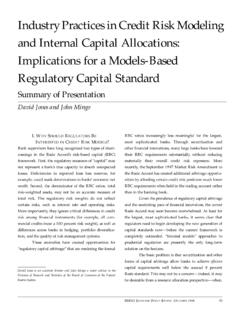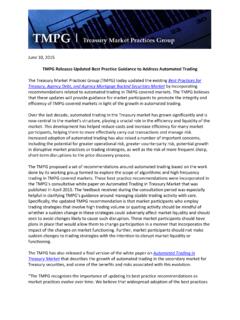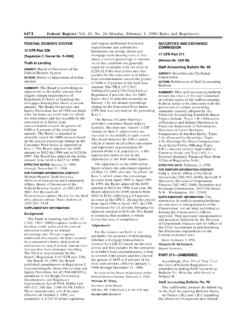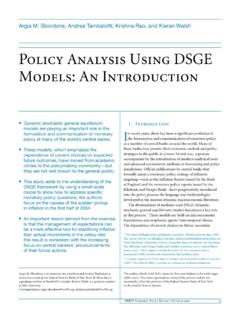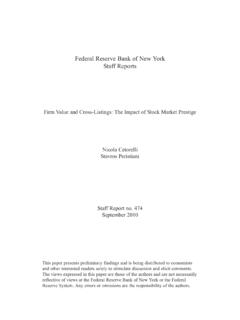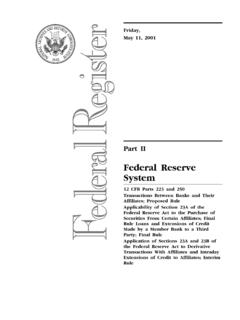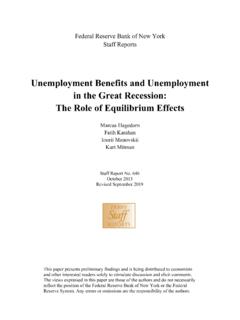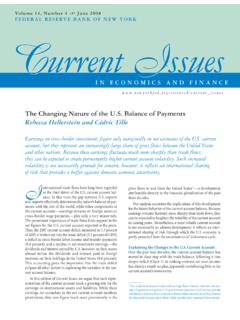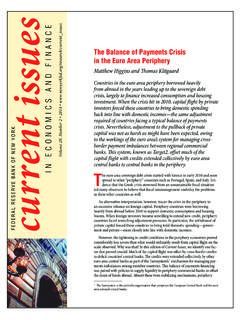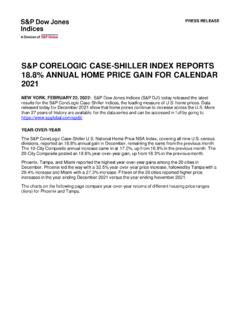Transcription of Progress Report: The Transition from U.S. Dollar LIBOR
1 Progress report : The Transition from Dollar LIBOR The Alternative Reference Rates Committee March 2021 (Updated as of March 31, 2021) 1 The Endgame for USD LIBOR The recent announcements from and regulators and LIBOR s administrator, ICE Benchmark Administration (IBA), have set out clear end dates both for new use of Dollar (USD) LIBOR and for its cessation as a representative, panel-based rate: The Federal Reserve Board, the Office of the Comptroller of the Currency, and the Federal Deposit Insurance Corporation have issued supervisory guidance encouraging banks to cease entering into new contracts that use USD LIBOR as a reference rate as soon as practicable and in any event by December 31, 2021 , noting that new USD LIBOR issuance after 2021 would create safety and soundness risks. Foreign regulators have stated that they are considering similar steps. On March 5, 2021, IBA stated that it will cease the publication of (i) the overnight and 1, 3, 6 and 12 months USD LIBOR settings immediately following the LIBOR publication on Friday, June 30, 2023 and (ii) all other LIBOR settings, including the 1 week and 2 months USD LIBOR settings, immediately following the LIBOR publication on Friday, December 31, 2021.
2 IBA stated that it will not have access to input data necessary to calculate LIBOR settings on a representative basis after those dates, IBA. The UK Financial Conduct Authority (FCA) issued a separate announcement confirming that IBA had notified the FCA of its intent to cease providing all LIBOR settings. The FCA confirmed that all 35 LIBOR settings will either cease to be provided by any administrator or will no longer be representative as of the dates set out by IBA. The FCA also stated that, subject to the establishment of new proposed powers under UK law, it would consult on the issue of requiring IBA to produce certain LIBOR tenors on a synthetic basis. The International Swaps and Derivatives Association (ISDA) subsequently announced that the FCA statement constituted an Index Cessation Event, setting the spreads that will be used for LIBOR derivatives among counterparties that have adhered to ISDA s IBOR Fallbacks Protocol or haven entered into new derivatives transactions using the standard ISDA definitions incorporating the IBOR Fallbacks Supplement.
3 The ARRC also announced that the statements constituted a Benchmark Transition Event under its fallback framework. The ARRC has stated its recommended spread adjustments for fallback language in non-consumer cash products will be the same as the spread adjustments applicable to fallbacks in ISDA s documentation for USD LIBOR . Taken together, these announcements lay out a definitive endgame for USD LIBOR : The cessation date for representative LIBOR is clear, the level of spread adjustments for ISDA and ARRC-recommended fallbacks has been set, and supervisory guidance has called for no new LIBOR contracts after end-2021, while allowing most legacy contracts to mature before the most widely used USD LIBOR tenors stop. The cessation of LIBOR will follow more than a decade of global reference rate reform efforts and extensive work within the to support the Transition from USD LIBOR to robust alternative reference rates.
4 2 A Decade of Reference Rate Reform Efforts Concerns about LIBOR rose to prominence following examples of manipulation of LIBOR s rate-setting process, which highlighted the secular decline in activity in the markets LIBOR is based on. In 2013, the Financial Stability Board (FSB) began a fundamental review of major interest rate benchmarks and of plans for reform. The FSB established a high-level group of global regulators and central banks to examine these issues as well as a Market Participants Group, which was asked to examine the feasibility and viability of adopting additional reference rates. In line with the recommendations of these groups, the FSB endorsed a two-pronged approach to further reforms. First, the FSB recommended continued work to strengthen LIBOR and other major interest rate benchmarks, and second, it recommended developing alternative, nearly risk-free reference rates. In the , the Financial Stability Oversight Council (FSOC) supported this approach.
5 Noting the vulnerabilities associated with LIBOR , FSOC recommended prompt identification of alternative interest rate benchmarks that are anchored in observable transactions and are supported by appropriate governance structures, and development of a plan to accomplish a Transition to new benchmarks. In response to the FSOC s recommendations and the objectives of the FSB, the Federal Reserve convened the Alternative Reference Rates Committee (ARRC). The ARRC s initial objectives were to identify risk-free alternative reference rates for USD LIBOR , identify best practices for contract robustness, and create an implementation plan with metrics of success and a timeline to support an orderly adoption. The ARRC accomplished its first set of objectives in 2017, identifying the Secured Overnight Financing Rate (SOFR) as the rate that represents best practice for use in certain new USD derivatives and other financial contracts. In its subsequent work, ARRC has developed a detail supporting framework for using SOFR, including tools such as fallbacks and recommended conventions for new use of SOFR in various products.
6 Despite substantive reforms enacted to strengthen the governance and oversight of LIBOR , sparse activity in term unsecured wholesale borrowing markets has remained a fundamental challenge to its production, with LIBOR sustained by use of expert judgement for many panel bank submissions. In 2017, Andrew Bailey, then head of the Financial Conduct Authority (FCA), noted that the lack of an active underlying market raised a serious question about the sustainability of [ LIBOR ] , and noted that the existence of LIBOR past 2021 could not be guaranteed. LIBOR s deficiencies have been further underscored during recent periods of market stress, such as March 2020, which saw further reductions in wholesale market activity. In the ARRC s Second report , the ARRC estimated that, as of the end of 2016, there were $199 trillion in outstanding exposures to USD LIBOR . Most of this (95 percent) arose from derivatives referencing USD LIBOR , but there were also about $10 trillion in cash market exposures.
7 At that time, the ARRC estimated that more than 80 percent of these exposures would roll off by the end of 2021 if market participants stopped new use of USD LIBOR . However, despite warnings from the 3 official sector that LIBOR would end, use of LIBOR has continued and actually increased. Updating the analysis, the ARRC now estimates that there are $223 trillion in outstanding exposures to USD LIBOR . Most of this increase again comes from derivatives exposures, but the estimated amount of business loans referencing USD LIBOR has also increased. These figures indicate that the task now before market participants in ending new use of LIBOR this year will be challenging. An estimated 67 percent of current LIBOR exposures will mature before June 2023, markedly reducing the number of legacy LIBOR contracts that must be dealt with after LIBOR s cessation. However, a still substantial amount of USD LIBOR exposures, an estimated $74 trillion, will remain outstanding beyond June 2023, underscoring the necessity of finding solutions for legacy LIBOR This third report from the ARRC describes the Progress that market participants have made in transitioning from USD LIBOR , and where Progress will need to materially accelerate in order for them to be adequately prepared for the end dates that have been laid out.
8 1 Of the estimated $74 trillion in USD LIBOR exposures outstanding beyond June 2023, the majority are derivatives which can be addressed through adherence to the ISDA Protocol. An estimated $ trillion in exposures will remain in bonds and securitizations, many of which may have no effective means to Transition away from LIBOR upon its cessation. See discussion around legislation and tough legacy contracts below. Interest rate swaps8146 Forward rate agreements470 Interest rate options2012 Cross currency swaps238 Interest rate options320 Interest rate f utures112Sy ndicated ndicated business ndicated CRE/Commercial Consumer Rate Securites (incl. CMOs) loan debt USD LIBOR Exposure:1 Source: Federal Reserve staf f calculations, BIS, Bloomberg, CME, DTCC, Federal Reserve Financial Accounts of the United States, , Shared National Credit, and Y-14 data. Data are gross notional exposures as of 2020Q4. 2 The f igures f or syndicated and nonsyndicated business loans do not include undraw n lines.
9 Nonsyndicated business loans exclude CRE/commercial mortgage Estimated amounts maturing af ter June 2023 based on historical pre-payment ratesTable 1: USD LIBOR Market Footprint by Asset Class1 Over-the-CounterDerivativesExchange TradedDerivativesMaturing After June 2023 ($TN)Currrently Outstanding ($TN)Business LoansConsumer LoansBonds4 The ARRC s Support for the LIBOR Transition Since the ARRC was first convened in 2014, it has taken a number of steps to build an infrastructure that would enable market participants to move from LIBOR to a more robust reference rate. The first years of the ARRC s work were spent identifying an alternative to USD LIBOR . As part of that process, ARRC members reviewed existing interest rate benchmarks and collected data on each of the potential markets that a prospective benchmark could be based upon, culminating in its Interim report and Consultation in 2016, which explained why existing term markets were not robust enough to support a LIBOR alternative and set out two leading candidates based on unsecured and secured overnight markets.
10 As part of its consultation, the ARRC also formed an advisory group to collect views from a diverse set of key end users. Following its consultations, the ARRC selected SOFR as its recommended replacement, documenting its process and the reasons for its choice in its Second report . The Federal Reserve Bank of New York, in cooperation with the Office of Financial Research, subsequently began publishing SOFR in April 2018. Since the selection of SOFR, the ARRC has focused on encouraging development of SOFR derivatives and cash markets and on addressing the problems in contractual fallback language used in LIBOR products. The ARRC first published its User s Guide to SOFR in 2019, which set out a range of ways in which SOFR could be used in cash products, along with conventions for floating rate notes (FRNs) and adjustable rate mortgages (ARMs), and it published further conventions for business loans, student loans, intercompany loans, and securitizations over 2020 and 2021.
